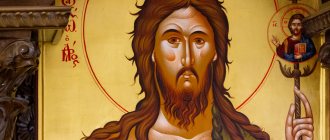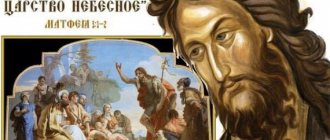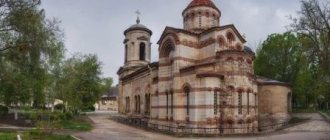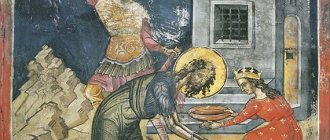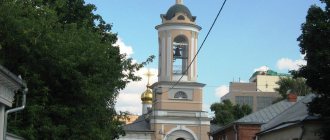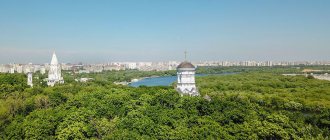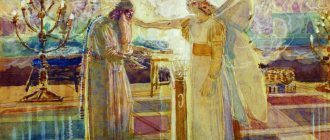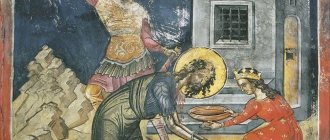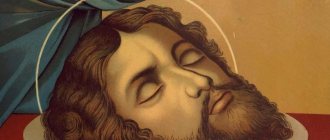| Hand of John the Baptist |
Hand of John the Baptist
, part of the relics (right hand) of the holy prophet and Forerunner of the Lord John the Baptist Celebrations on January 7 (transfer of the shrine from Antioch to Constantinople in 956), October 12 (transfer from Malta to Gatchina in 1799), as well as the days of memory of John the Baptist
A description of the right hand of John the Baptist has been preserved, belonging to the boyar Boris Petrovich Sheremetev (1652–1719), the future field marshal general of the Russian troops, in his notes about a nine-day trip to Malta in 1698, he writes:
“On May 8th, the boyar in the Church of St. John the Baptist, in of which that day was the Grand Master, and all the gentlemen listened to the Liturgy and all received communion.
At the end of the Liturgy, the hands of the Holy Great Prophet, Forerunner and Baptist of the Lord John were carried out in procession and singing, and everyone was honored to kiss it... That Holy Forerunner's hand is up to the wrist, and the appearance of the power is very amazing, as if of a recently deceased person. They show this hand publicly only a few times a year.” The incorruptible holy hand of the Prophet does not have a little finger or middle finger. Since 1200, the little finger was in Constantinople in the Church of the Holy Prophet John the Baptist in the Studite Monastery. During the conquest of Constantinople by the Turks, the temple was turned into a mosque, and the little finger ended up in the collection of shrines of the Sultan and to this day remains in the Istanbul Museum in a hand-shaped ark. The middle finger of the right hand of John the Baptist was brought at the beginning of the 13th century by Saint Sava, Archbishop of Serbia to the Constantinople Patriarch Germanus II and the founder of the Nicaean Empire Theodore I Lascaris (1204–1222). For many decades, the shrine was kept in the Žić Monastery in Serbia (the ancient diocese of Pec), the residence of the Patriarchs, where the coronation of the Serbian Kings took place. In 1458, when the Serbian kingdom fell under the blows of the Turks, the holy finger was transferred to Morea (the southern peninsula of Greece) to the brother of the last Byzantine Emperor Constantine XI Palaiologos - Thomas Palaiologos, who, fleeing from the Turks, moved to Rome and handed over the Shrine to Pope Pius II (1458–1464). Pope Pius II transferred the holy finger of John the Baptist to Siena to the Church of St. Mary of Siena, where once a year the shrine is taken out for veneration by believers who come to Italy from all over the world on this day.
History of the Transfer of the Hand
The honorable body of Saint John the Baptist was buried near the grave of the holy prophet Elisha in the Samaria city of Sebastia. Returning from here to his homeland in Antioch, the holy Apostle and Evangelist Luke wished to take with him the body of the Prophet. But the inhabitants of Sebaste allowed only the right hand with which our Lord Jesus Christ was baptized to be transferred.
The fate of the right hand of the holy prophet John is closely connected with the historical events taking place in the countries in which she stayed. For nine centuries the right hand was in Antioch. During the reign of Julian the Apostate, when a cruel persecution of Christians began, and churches and the relics of saints were burned, the inhabitants of Antioch hid the holy hand in one of the city towers, and it survived. After the death of the lawless king, Christians carried the right hand of the Forerunner out of the tower. After this, great miracles were performed by her. On Epiphany Christmas Eve, the bishop raised his honest hand, which in some years straightened, and in others shrank, predicting a harvest or famine. When Antioch was captured by the Hagarians, the priceless relic was captured by them.
In the century, during the reign of the Byzantine emperor Constantine Porphyrogenitus, one deacon from Antioch named Job was able to carry the hand of the Baptist to Christian lands, to the city of Chalcedon. From there she was solemnly taken to Constantinople, where she stayed in various churches, including the Church of St. Sophia. Constantinople was captured by the Turks in 1453.
From Constantinople the shrine came to the island of Rhodes. Wanting to win over the knights of the island to his side, the Turkish Sultan Bayezid II sent an honest right hand to the Master of the Order as a sign of favor. But the peace did not last long - in 1522 the Turks conquered Rhodes. The knights fled to Malta, taking with them, in addition to the right hand of the Prophet, part of the Life-Giving Cross of the Lord and the Philermos Icon of the Mother of God.
These three shrines were kept in the tomb of the cathedral for two and a half centuries, until 1798, when Malta was captured by Napoleon I. The Order, fleeing destruction, chose the Russian Emperor Paul I as its patron. In 1799, the great shrines arrived in the Russian Empire, where it was preserved for a century with great reverence. Paul I allocated over 7 pounds of gold to the jeweler F.K. Teremen, who made a golden chasuble for the Filermo icon, strewing it with precious stones. He also made two arks - for the right hand of St. John the Baptist and particles of the Holy Cross.
After the violent death of Paul I, which occurred on March 1 (14), 1801, at the hands of the conspirators, the feast of the transfer from Malta to Gatchina of part of the tree of the Life-giving Cross of the Lord, the Philermos Icon of the Mother of God and the right hand of the Holy Prophet John the Baptist and Baptist of the Lord (ceremonially celebrated only in 1800 g.), only appeared in the month's word and did not acquire its appropriate All-Russian and church-wide significance. But every year until 1919, on October 12 (25), a solemn service was held in the court cathedral of the Winter Palace in the name of the Savior, the Image Not Made by Hands.
Before the revolution of 1917, these priceless shrines were located in Russia: first in Gatchina, then in St. Petersburg, Moscow, and again in Gatchina. During the years of revolutionary turmoil and the period of persecution of the Russian Orthodox Church, they were miraculously saved from desecration and transported abroad. Since the Maltese relics were the property of the imperial family, they were transported through Estonia to Denmark, where at that time the mother of the holy passion-bearer emperor Nicholas II, Dowager Empress Maria Feodorovna, lived. After her death in 1928, the Empress’s daughters, Grand Duchesses Olga and Ksenia, handed over the shrines to Metropolitan Anthony (Khrapovitsky), who transported them first to Germany, and then, in 1932, to Yugoslavia, where they became the property of the royal family of Karageorgievich. They were given to King Alexander Karageorgievich in gratitude for the fact that Serbia gave shelter to many Russian emigrants.
Their further fate is as follows. King Peter II Karageorgievich, leaving for Great Britain in April 1941, met with Patriarch Gabriel at the Gorny Ostrog monastery and handed over the shrines to him for safekeeping. Before being arrested and sent to a concentration camp, the Patriarch managed to hide them with Archimandrite Leonty (Mitrovich). By God's providence, thanks to the zeal of the clergy and pious believers, the great shrines were preserved during the days of the German occupation. After the war, they were removed from the monastery by members of the Yugoslav secret services and taken to the city of Titograd (Podgorica).
Since January 20, 1978, the day of remembrance of St. John the Baptist, his honorable right hand and part of the Holy Cross of the Lord rests in the Mother of God Monastery in the city of Cetinje in Montenegro, and the Philermo Icon of the Mother of God is kept in the Cetinje Museum. Only in 1993, during a visit to Montenegro by His Holiness Patriarch Alexy of Moscow and All Rus', the Maltese shrines were again revealed to the world.
In June 2006, accompanied by a representative of His Holiness the Patriarch of Serbia, the right hand was temporarily brought for veneration to Moscow, Nizhny Novgorod, Cheboksary, Yekaterinburg, Chelyabinsk, Saratov, Vladikavkaz, Rostov-on-Don, Minsk, St. Petersburg, Kyiv.
Fatal dance
John the Baptist, born in Judea (only six months earlier than Jesus Christ), was forced to spend most of his life in the desert. It just so happened that his father, the high priest Zechariah, somehow angered King Herod the Great and was killed by the ruler’s servants right in the Jerusalem temple , and his wife and newborn son simply miraculously managed to escape from the city. However, soon John’s mother also died, and the boy was left completely alone. In the desert, the saint led an ascetic lifestyle. His food was wild honey and dried locusts, and his clothes were replaced by scraps of camel skins When John was thirty years old, he settled in a small hut near the Jordan River, where he preached to people about the imminent coming of the Messiah - the Savior of the human race - and baptized those who believed in the waters of the stream. Here, shortly before the arrest of the Forerunner, the Savior himself came, wishing to accept from John the sacred sacrament At that time, Judea was ruled by King Herod Antipas, a protégé of the Roman emperor, a tyrant who placed himself above all laws. Not caring about the principles of morality, this tyrant took his wife Herodias from his brother, whom he placed on the throne next to him, to the great indignation of his subjects. And only John the Baptist dared to openly condemn the behavior of the ruler and vehemently denounced royal depravity in his fiery sermons. Retribution was not long in coming, and soon the saint was arrested and thrown into prison. However, Herod Antipas did not dare to execute John for a long time. He feared that the death of his beloved preacher would cause popular unrest, from which even the legionnaires of the Roman governor would not protect him. But Queen Herodias decided by any means to achieve the death of the ragged tramp who dared to talk nasty things about her. And a “happy” chance helped her with this. At the ruler's birthday, her daughter Salome performed a fiery dance, which Herod really liked. The pleased king promised to fulfill any desire of his stepdaughter, and she, at the instigation of her mother, asked him for the head of John the Baptist. Since the promise was made in the presence of high-ranking guests, Herod did not dare to go back on his word. In prison, the executioner beheaded the preacher, and the desired reward was solemnly presented to the dancer.
How to get there, where to park
Cetinjski Monastery is located at: Montenegro, Priestonica Cetinje. It is on the southeastern outskirts of the city of Cetinje. A very interesting word is Priestonica. As I understand it, it means “main city”. Not the capital, but... the main one. Like this.
Of course, the most popular way to get to the monastery is as part of an organized excursion. They will bring you from anywhere in Montenegro, tell you about it and take you to the place.
You can also get to the former capital of Montenegro by regular bus. Yes, it is the cheapest, but not the most comfortable option. For example, it takes 45 minutes to drive from Podgorica, and about the same from Budva.
For independent travelers, it will be more convenient to rent a car in Montenegro. In Cetinje you need to take the M 2.3 or P1 highway. But, I’ll tell you right away, the road is winding, you won’t be able to drive fast. The highway itself is excellent, 2 lanes. From time to time there is a 3rd lane for overtaking, which is very convenient on serpentine roads.
If you are coming from the southern cities of Montenegro: Budva, Bar, you can’t go wrong with your choice of road. But from the northern cities: Tivat, Kotor, Herceg Novi - the navigator shows a shorter route: the R1 highway. It runs through a mountain range, and local residents did not advise driving there, since the serpentine is narrow and very winding. Therefore, from the Lustica peninsula, where I lived, I went to Cetinje via Budva.
The road is fantastically beautiful! The views from the mountain slopes are simply amazing! Here is a view of Budva, located in a gorge between the mountains. And with each turn of the serpentine, it becomes smaller and smaller.
There are observation platforms along the road. There are quite a lot of them. So you can admire the surrounding spaces endlessly! There are also monuments. Here, for example, is a huge broken anchor.
Snow-capped mountain peaks are visible in the distance. Below, by the sea, the temperature in February was somewhere between +10 - +15 degrees. Therefore, snow in the mountains seemed something far away. But suddenly you realize that it’s not so far away: after all, Cetinje is located quite high in the mountains. There were small snowdrifts on the side of the highway! The temperature “overboard” is +4 degrees. True, in the warm sun the weather feels much warmer.
So when going to the Cetinje Monastery, located in the mountains, do not forget to take a warm sweater or even a jacket if you are traveling in winter.
Not far from the monastery there is a huge city parking lot. Its coordinates are: 42.38566, 18.92338. Judging by the presence of a barrier, it must be paid. But in winter, not during the tourist season, entry was free. This is how lonely my rental car looked in this parking lot.
I saw another parking lot, to the right of the monastery. Apparently, it should be free even in summer. Its coordinates are: 42.38848, 18.9224. There were also several cars parked right next to the entrance to the monastery. But, most likely, this is a place for transport of the monastery servants.
The Cetinje Monastery can be called the Orthodox center of the entire country of Montenegro, both in the past and in the present. So, if there is such an opportunity, then, as they say now, “a must visit!” And besides, the town of Cetinje itself - the former capital of Montenegro - deserves your attention. A walk through the mountainous and beautiful streets will definitely be memorable. I propose now to join me in seeing what the ancient city of Cetinje in Montenegro has in store for travelers.
Coordinates of the Cetinje Monastery: 42.38777, 18.9218. Church of the Nativity of the Virgin Mary on Dzhipur is located here: 42.38689, 18.9235
On the map you can determine the exact location of the monastery in Cetinje (click “+” or “-“ to zoom in or out the image.
To stay in Cetinje for a few days, you can easily rent an apartment or room on Airbnb, or book a hotel in any convenient location in the city through Booking.
My trip to the Montenegrin town of Cetinje and the Cetinje Monastery took place on February 7, 2021.
The map below shows other attractions of Montenegro that I was able to visit.
Share in the comments below which unusual churches and monasteries you have visited, and which of them made the greatest impression.
Relics of St. Peter Cetinski
In the world, Peter I Petrovic Njegos was the ruler and metropolitan of Montenegro, he was canonized under the name of Cetinski, and was canonized by the Serbian Orthodox Church. Born in Njegusi in 1748, the priest became a deacon at the age of 17 and was sent to Russia for training. After the death of the anarchist Arseniy Plamenac in 1784, he was chosen by the Montenegrin Council to take the throne.
The saint died at the age of 81 and was buried in the monastery church. Four years later, by decree of Peter II, the coffin and incorruptible relics were opened. At the same time, he was canonized. Now the Cetinje Monastery of the relics of St. Peter of Cetinje is kept in an open reliquary along with the posthumous troparion and kontakion made.
Key facts about Cetinje
What you need to know about the ancient capital of Montenegro before your trip:
- the city is located at 42°23´36´´ north latitude and 18°55´19´´ east
longitude;
- Cetinje area - 910 sq. km.;
- the city lies at an altitude of 690 meters above the sea;
- There is a temperate continental climate here;
- time zone - UTC+1, in summer - UTC+2;
- population in 2021 - 15,137 people;
- postal code - 81250;
- telephone code - +382 41;
- City Day is celebrated on November 13th.
Temple on Jipura - site of an old monastery
Next to the monastery, in the shape of an elongated rectangle, there is a small Church of the Nativity of the Virgin Mary on Dzhipur (Castle Church).
This Church of the Mother of God on Ćipuru (Crkva na Ćipuru) is located on the site of the former Cernoevich monastery. As written in historical documents, the old church was surrounded on 3 sides by a colonnade. Nearby there were outbuildings, cells, chambers for the metropolitan and a small church in the name of St. Apostle Peter. Loopholes were carved into the walls of the buildings. The entire monastery complex was surrounded by a ditch with water and a fence made of sharp stakes.
Today it is the temple of the Cetinje Seminary. Inside it there is an amazingly beautiful iconostasis made by Russian masters of the 19th century from St. Petersburg. In addition, in the Church of the Nativity of the Blessed Virgin Mary the remains of the Montenegrin king Nicholas and his wife rest, and the tomb of Ivan Chernoevich is also located there.
Epitrachelion of Saint Sava
The epitrachelion is a part of the liturgical vestment characteristic of an Orthodox priest and bishop. It looks like a long ribbon that goes around the neck and with both ends in front goes down to the chest. It is worn over a cassock or cassock. According to the canons of the church, it is impossible to officiate without it.
The Cetinje Monastery is home to the stole of St. Sava, one of the most revered saints in the Serbian Orthodox Church, a cultural and religious figure who lived approximately 1169-1236. He is considered the patron saint of schools.
Big politics
But after several centuries, the great relic had to look for another refuge. In the 10th century, Muslim troops captured Antioch, but the local clergy managed to transport the right hand of the Forerunner to Constantinople. Here she was placed in the Hagia Sophia, where she remained until 1453. It is known that in the 13th century, two fingers were separated from the hand of the Forerunner - the little finger and the ring finger, which became shrines of other temples in Constantinople. Today one of them is in the Istanbul Museum, the other is kept in Italy in the Siena Cathedral. When the capital of Byzantium fell under the onslaught of the Turkish army, the fate of the sacred relic could have been disastrous. But then big politics “interfered” in the matter. At that time, the half-brother of the conquering Sultan Bayazit II, a serious contender for his throne, was languishing in captivity among the Knights of St. John from the island of Rhodes. And the invader “generously” gave the Christian knights the right hand of their heavenly patron, so that they would not rush to release his rival. But the shrine was not in Rhodes for long. In 1522, the island was besieged by Sultan Suleiman I, and the shrine again had to embark on a long journey. For almost a decade, the defeated knights, carefully hiding the precious relic, wandered around Europe, until the head of the Holy Roman Empire, Charles V, handed over the island of Malta to them.
Interesting sights of Cetinje
On the descent from the observation deck towards the monastery there is a glazed building in which there is a relief map of Montenegro. You can get inside through the museum complex in the residence of Peter II Njegus, entrance tickets are also sold there:
- to the King Nikola Museum - costing 5 euros per adult and 2.5 euros per child;
- to the Njegushe Museum - 3 euros per adult, 1.5 euros per child;
- to the Gallery of Modern Art - cost 4 euros per adult, 2 euros per child;
- to the Historical Museum - 3 euros per adult, 1.5 euros for children;
- to the Ethnographic Museum - cost 2 euros per adult, 1 euro per child;
- to the building of the Relief Map of Montenegro - costing 1 euro per person.
For 10 euros you can purchase a single ticket to all museums. For a child you need to pay 5 euros.
Heading further towards the city, you can see the monument to ruler Ivan Crnoevich, King Nikola Square and the Royal Museum located on it. A beautiful city park begins at the monastery, and right behind the Museum of King Nikola there is a picturesque Njeguši forest.
The tourist information center sells a variety of souvenirs and postcards in many languages. Here you can rent a bicycle or go to the souvenir market from here.
Cetinje
When talking about the Cetinje Monastery, one cannot fail to mention the wonderful city in which it is located. The Constitution of Montenegro equalizes its rights with the official capital Polgorica. The city has the official residence of the President and the Ministry of Culture of the country. It is small in area, the population (according to 2011 data) is almost 14 thousand people. Located in a picturesque region: an intermountain basin, at the foot of the Lovcen mountain range.
According to statistics from meteorologists, it is one of the rainiest cities in Europe. The history of its existence supposedly begins in 1440; 44 years later the Cetinje Monastery was founded in it, where, as already mentioned, one of the main shrines of the Orthodox Church is located.
A trip to it can be combined with a resort holiday, because the Adriatic Sea coast is only 12 km away, and 15 km away is Lake Skadar, the largest in the Balkans. The city belongs to a seismically active zone with the possibility of earthquakes with an amplitude of up to 8 points. A visit to this Cetinje will be interesting for everyone. The city has been the cultural and political center of the country for five centuries. Every year, numerous festivals and holidays are organized here, the doors of museums are open for guests and the gates of beautiful parks are thrown open.
